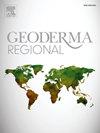整合地面和轨道反射率数据提高了土壤属性建模的性能
IF 3.3
2区 农林科学
Q2 SOIL SCIENCE
引用次数: 0
摘要
全面了解土壤属性对有效的环境管理至关重要。地质技术为传统的土壤测量方法提供了另一种选择。本研究评估了来自地面和轨道传感器的多光谱数据使用机器学习算法预测巴西中部Rhodic Ferralsols土壤属性的潜力。对37份土壤样品(深度0 ~ 20 cm)的理化和光谱属性进行了采集和分析。利用ASTER(一种提供多光谱数据的卫星传感器)从可见光到短波红外提取光谱特征,与Fieldspec Pro 4的实验室高光谱数据进行比较,并重新采样到ASTER波段。随机森林(RF)和多元线性回归(MLR)分别或联合使用光谱库对土壤属性进行建模。结果表明,遥感器之间的光谱响应相似,表明地面遥感器高光谱数据的重采样可以作为轨道数据的可靠参考。由于条件可控,减少了湿度和大气的干扰,地面传感器和组合方法与土壤属性的Pearson相关性高于轨道传感器。组合传感器的MLR有效预测土壤属性,黏土和有机质的R2分别为0.65和0.69。由于数据集有限,RF表现出较低的性能,碱饱和度的R2为0.32,阳离子交换容量的R2为0.30。结合地面和轨道传感器可以改善土壤属性建模,然而,需要稳健的采样、图像处理、传感器测试、数据集和算法。这项研究强调了整合多层次遥感进行有效土壤分析和制图的潜力,有助于可持续的环境管理。本文章由计算机程序翻译,如有差异,请以英文原文为准。

Integrating terrestrial and orbital reflectance data improves the soil attribute modeling performance
A comprehensive understanding of soil attributes is crucial for effective environmental management. Geotechnologies offer an alternative to traditional soil surveying methods. This study evaluated the potential of multispectral data from terrestrial and orbital sensors to predict soil attributes of Rhodic Ferralsols in Central Brazil using machine learning algorithms. Physicochemical and spectral attributes of 37 soil samples (0–20 cm depth) were collected and analyzed. Spectral signatures were extracted from visible to shortwave infrared using the ASTER, a satellite-based sensor providing multispectral data, for comparison to laboratory hyperspectral data from Fieldspec Pro 4, and resampled to ASTER bands. Random Forest (RF) and Multiple Linear Regression (MLR) modeled the soil attributes using the spectral libraries, individually and combined. Results showed similar spectral responses between the sensors, indicating that resampling hyperspectral data from terrestrial sensors can be a reliable reference for orbital data. Due to controlled conditions and reduced interference from moisture and atmosphere, the terrestrial sensor and combined approaches had a higher Pearson correlation with soil attributes than the orbital sensor. MLR with combined sensors effectively predicted soil attributes, achieving R2 of 0.65 for clay and 0.69 for organic matter. RF showed lower performance, with R2 of 0.32 for base saturation and 0.30 for Cation Exchange Capacity, attributed to limited datasets. Combining terrestrial and orbital sensors improves soil attribute modeling, nevertheless, it requires robust sampling, image processing, and sensors testing, datasets, and algorithms. This study highlights the potential of integrating multilevel remote sensing for efficient soil analysis and mapping, contributing to sustainable environmental management.
求助全文
通过发布文献求助,成功后即可免费获取论文全文。
去求助
来源期刊

Geoderma Regional
Agricultural and Biological Sciences-Soil Science
CiteScore
6.10
自引率
7.30%
发文量
122
审稿时长
76 days
期刊介绍:
Global issues require studies and solutions on national and regional levels. Geoderma Regional focuses on studies that increase understanding and advance our scientific knowledge of soils in all regions of the world. The journal embraces every aspect of soil science and welcomes reviews of regional progress.
 求助内容:
求助内容: 应助结果提醒方式:
应助结果提醒方式:


